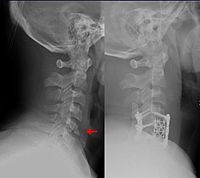
Photo from wikipedia
Background The purpose of our study was to compare 2 commonly used highly successful cruciate-retaining knee designs on the basis of patient-reported outcome measures (PROMs), range of motion (ROM), and… Click to show full abstract
Background The purpose of our study was to compare 2 commonly used highly successful cruciate-retaining knee designs on the basis of patient-reported outcome measures (PROMs), range of motion (ROM), and anterior knee pain (AKP) at a minimum follow-up of 5 years. Methods A cohort of 65 patients underwent unilateral total knee arthroplasty, from January 2013 to December 2013, using NexGen Cruciate Retaining (Zimmer Biomet, Warsaw, IN), a nonmorphogenic knee (NMK) system. They were subsequently operated upon for the contralateral knee using Persona Cruciate Retaining (Zimmer Biomet, Warsaw, IN), a morphogenic knee (MK) system between January 2014 and June 2014. Of the 65 patients, 63 participated in this study. All the patients were compared preoperatively and postoperatively on the basis of PROMs, ROM, and AKP. Results On the basis of PROMs, ROM, and AKP, there was a statistically significant difference between the 2 groups favoring the MK group, with an ROM of 126.14° in the MK group as compared with 120.76° in the NMK group and P value of <.01. Conclusions PROMs, ROM, and AKP improved significantly over time after total knee arthroplasty using both MK and NMK implants; however, the outcomes of the former were better than those of the latter, although this difference was not clinically significant.
Journal Title: Arthroplasty Today
Year Published: 2020
Link to full text (if available)
Share on Social Media: Sign Up to like & get
recommendations!